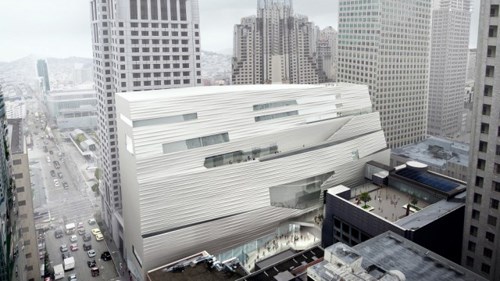Warm thoughts about architecture in cold weather
Composite materials have come a long way in the architecture world and are now poised to be a major player in this high-profile, high-growth industry.

Semi-structural composite panels are playing a big role in the design and construction of the San Francisco Museum of Modern Art.
Sitting here looking out at the snow is making me think of warmer places. Warmer places brings to mind Florida – and the first time I went to Florida to cover a trade show, ACMA’s (then CFA’s) Composite 2001 in Tampa. That was when I met Bill Kreysler of Kreysler and Assoc., and nervously attended a meeting of the ACMA’s Architectural Division. My knowledge of composites was still very rudimentary at that point, and I hadn’t thought much about the use of composites in architecture, but Composites Technology magazine had run a story on fiberglass architectural decorative elements in 1996, and another in October 2000, about the use of composites to seismically upgrade the Marin County, CA, US, government building designed by Frank Lloyd Wright.
That 2001 Division meeting sparked an enduring interest in composites for architecture and civil construction, for me, and led to many conversations with Kreysler and others, which in turn resulted in some great articles over the ensuing years — articles on bridges, buildings, Denver’s giant bear sculpture, and later, fire safety, building code changes and architectural facades and building elements being embraced worldwide. The picture above shows Kreysler’s façade for the San Francisco Museum of Modern Art that’s currently under construction.
It is gratifying to look back over the past 14 years and see just how far this market sector has come. In addition to generating great story topics, ACMA and the Architectural Div. have made important progress in ensuring the inclusion of composites in building codes. I don’t believe I’ll soon have a repeat of the telephone call to a New York-based architect, at least 10 years ago, for a story. When I asked his view on composites usage in commercial buildings, he replied, “I’ll never use composites in a building.”
This topic has already been covered extensively by several CW writers, including my colleague Ginger Gardiner, who posted an interesting blog a couple of months ago about an event at the University of Southern California’s School of Architecture. She also visited and reviewed the ACMA Architectural Div.’s exhibit at the 2014 American Institute of Architects’ (AIA) national meeting, a “Composites Pavilion” in the exhibit hall that provided information for architects and designers about composite materials. That event was the springboard for the introduction of some really significant new products, including the new foundation wall system from Epitome. The group will mount another, larger Composites Pavilion at the 2015 AIA conference.
Ashland Performance Materials has been instrumental in helping to promote the growth of architectural composites, including development of a Web site called Compositebuild.com. The site is an informational hub that seeks to connect architects and builders to composites, and offers educational pages, case studies and links to composite firms and best practices. Another resource showcasing the reach of composites into architectural design is a blog called Composites and Architecture, an inspiring and visually stunning site built by Kreysler and Assoc. with input from contributors around the world. It shows how composites are currently being used in buildings as well as in artistic design.
The point of all this is this: Composites have made great strides in buildings and architecture because of the hard work of some industry champions to get the word out. It’s all about increasing awareness, offering education, explaining the technology, overcoming prejudices, discussing total lifecycle costs and increasing interest level in a community so that material and fabrication costs can come down as demand increases. The fact that recent building code changes allow use of composites means that architects and designers need to get up to speed on our materials and how they can be applied, to great benefit. As I wrote in my February 2013 architectural article, a well-known architect (who happens to be a neighbor of mine) said, “Architects are always intrigued by new materials. If they can perform and meet code and provide some unusual capability, then it’s worthwhile, despite added cost.”
Good to write about a hot composites trend on a very cold, snowy day.
Related Content
R-Tech Materials offers accredited composite rebar testing
The independent U.K. lab has has developed a comprehensive suite of materials testing capabilities tailored to the growing demands of the construction sector.
Read MoreSwedish parking garage to incorporate decommissioned wind blades
Architect Jonas Lloyd is working with Vattenfall to design the multistory building with a wind blade façade, targeting eco-friendly buildings and creative ways to remove blades from landfills.
Read MoreCCG meets customer demand with StormStrong utility pole lineup
Additional diameters build on the portfolio of resilient FRP pole structures for distribution and light pole customers.
Read MoreUMaine ASCC secures $8 million USDOT partnership
Building on its years of work in composites, ARPA-I funding will enable the university to further develop and prototype low-cost composite bridge materials via the X-Bridge program.
Read MoreRead Next
Ceramic matrix composites: Faster, cheaper, higher temperature
New players proliferate, increasing CMC materials and manufacturing capacity, novel processes and automation to meet demand for higher part volumes and performance.
Read MoreNext-gen fan blades: Hybrid twin RTM, printed sensors, laser shock disassembly
MORPHO project demonstrates blade with 20% faster RTM cure cycle, uses AI-based monitoring for improved maintenance/life cycle management and proves laser shock disassembly for recycling.
Read MoreScaling up, optimizing the flax fiber composite camper
Greenlander’s Sherpa RV cab, which is largely constructed from flax fiber/bio-epoxy sandwich panels, nears commercial production readiness and next-generation scale-up.
Read More












